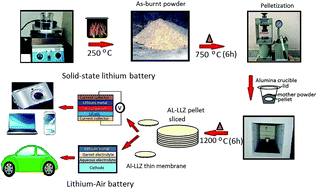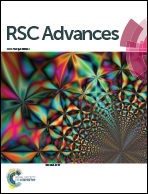Facile synthesis of high lithium ion conductive cubic phase lithium garnets for electrochemical energy storage devices†
Abstract
Li7La3Zr2O12 (LLZ) lithium garnet is a prospective solid electrolyte for all-solid-state lithium batteries and Li-air batteries due to its high room temperature Li+ conductivity (10−4 S cm−1) and chemical stability against lithium metal and few aqueous solutions. Preparation of cubic phase (Ia![[3 with combining macron]](https://www.rsc.org/images/entities/char_0033_0304.gif) d) LLZ by a solid state synthesis technique requires repeated heat treatments along with intermittent grinding and long duration sintering. However for industrial production, low cost, scalable and fast synthesis techniques are essential. In this work, LLZ and Li6.28Al0.24La3Zr2O12 (Al-LLZ) lithium garnets were successfully prepared in shorter duration times by a simple combustion technique and also the effect of the excess lithium source on the structure, Li+ conductivity and morphology of the synthesized materials was investigated. Powder X-ray diffraction (PXRD) and Raman spectra of the as-burnt powder sintered at 950 °C revealed a tetragonal phase (I41/acd) for LLZ whereas a high conductive cubic phase (Ia
d) LLZ by a solid state synthesis technique requires repeated heat treatments along with intermittent grinding and long duration sintering. However for industrial production, low cost, scalable and fast synthesis techniques are essential. In this work, LLZ and Li6.28Al0.24La3Zr2O12 (Al-LLZ) lithium garnets were successfully prepared in shorter duration times by a simple combustion technique and also the effect of the excess lithium source on the structure, Li+ conductivity and morphology of the synthesized materials was investigated. Powder X-ray diffraction (PXRD) and Raman spectra of the as-burnt powder sintered at 950 °C revealed a tetragonal phase (I41/acd) for LLZ whereas a high conductive cubic phase (Ia![[3 with combining macron]](https://www.rsc.org/images/entities/char_0033_0304.gif) d) for Al-LLZ. Among all the prepared samples, Al-LLZ with 10 wt% excess lithium source sintered at 1200 °C for just 6 h exhibits a maximized relative density of 95% and total (bulk + grain-boundary) Li+ conductivity of 5.1 × 10−4 S cm−1 at 30 °C with a particle size of around 613 nm.
d) for Al-LLZ. Among all the prepared samples, Al-LLZ with 10 wt% excess lithium source sintered at 1200 °C for just 6 h exhibits a maximized relative density of 95% and total (bulk + grain-boundary) Li+ conductivity of 5.1 × 10−4 S cm−1 at 30 °C with a particle size of around 613 nm.


 Please wait while we load your content...
Please wait while we load your content...